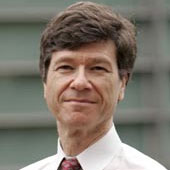Message to Washington: Get Serious About Development
How committed are U.S. policymakers to development assistance?
April 8, 2005
I have to confess that, while I have come to Washington, D.C. for many years, rarely before has this city been as filled with so much appealing rhetoric and so little action.
Let me give you an example. I recently read an important document that stated, “Today more than ever, U.S. foreign policy toward the developing world plays a vital role in the global balance between conflict and peace.
"U.S. national security challenges are increasingly complex, and the role of development is recognized as pivotal.”
The document goes on to say: “This is reflected in President Bush’s National Security Strategy of the United States, issued on September 17, 2002, which for the first time elevated development as the third component of U.S. national security — alongside defense and diplomacy.”
Good words, indeed. They strike me as being straightforward and right on target. I quoted them from the Budget Request for the FY2006 International Affairs Account, dubbed the “150 Account.”
Unfortunately, these words mean little in reality when one realizes that the actual budget cuts development assistance by $345 million. That is the reality we face. These are nice-sounding words and harsh numbers.
This matters a great deal, because the realities of the people who live in developing countries several thousand miles away are very different and ever more challenging. They require more resources, not less.
I am particularly concerned with this: a total of $24 million is budgeted for five key regional countries — Djibouti, Ethiopia, Kenya, Nigeria and South Africa.
These funds are to be used to support economic growth, democratization and anti-crime and anti-corruption activities. Twenty-four million dollars is intended to cover all of that for 275 million people. Those nine cents per person will be spread awfully thin.
Examining budget requests like that, I wonder how we intend to be seen around the world. Shortsightedness and stinginess cannot be our national policy.
At the same time, due to common confusion, we blame the extreme poor for their problems. We consistently overlook the practical and affordable steps that communities are taking on their own.
If we help them, they could actually succeed, and we would actually see the results for which critics howl. If we did help, consider the amazing differences! Children could stay alive. Water could be safe. Children would be in school thanks to the provision of school meals.
We can reach these goals through practical, low-cost, specific, targeted and measurable steps. These are real steps — not lofty concept papers — that can make a difference on the ground.
While the costs are low, they are real. Can we afford it? Of course we can. The United States routinely spends tens of billions of dollars on projects that the American people enthusiastically support.
Right now, when it comes to development spending, we have grandiose titles for ambitious programs, but we fail to implement them with actual budgetary support. Many of the measures currently pursued in our International Affairs Account are far too small programs.
If we mean, for the first time in history, to elevate development as the third component of U.S. national security, alongside defense and diplomacy — as President Bush intends — then that announcement should be accompanied by far increased resources for development.
Development must be one of the three equal pillars of our National Security strategy.
One pillar, the U.S. military, enjoys roughly $500 billion of support, but the development pillar receives only roughly $16 billion.
We spend over 30 times more on our military than we do on development assistance. That is not a sustainable strategy. A weak pillar cannot provide the proper support.
Discouragingly, of that $16 billion — already a small sum — we direct most toward strategic states, such as Afghanistan, Colombia, Iraq and Pakistan. Afghanistan alone will receive more development assistance than will all of sub-Saharan Africa in the FY 2006 budget.
We do not need a single new promise, a single new commitment, or even one new program. The rich countries first committed to giving 0.7% of GNP to development assistance as early as 1970.
Most recently, to reverse the tide of declining aid levels, the rich countries met in Monterrey in 2002 and arrived at the Monterrey Consensus.
Paragraph 42 of the consensus made the point explicitly: “We urge developed countries that have not done so to make concrete efforts towards 0.7% of GNP as official development assistance.”
As a nation, we committed to 0.7% — and to do so along a specific timetable. The President of the United States himself was present at Monterrey.
The United States stands at 0.15% of GDP — the lowest share of income given by any rich country — and we do not see any concrete efforts underway to close that gap.
We are short by $65 billion each year, which may seem like a vast sum, but it represents just 0.5% of our GNP. Our financing gap is short by only 50 cents of every $100 of our national income.
If we expect to be viewed as a responsible part of the industrialized world, we will have to commit. Right now, we are giving Africa about $0.02 out of every $100 dollars. We have not endorsed the Millennium Development Goals.
Practically every government in the world has done so, but we hesitate. I believe that the time has come to join the rest of the world and fulfill our commitments, which are real and specific. After all, the security of our nation depends on it.
This essay was adapted from Jeff Sachs’ speech at the Center for Global Development’s conference, “Missing the Mark: Girls’ Education and the Way Forward,” in Washington, D.C. on March 2, 2005. For a transcript of the conference, click here.
